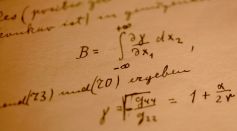PHYSICS & MATH
Transition of Subatomic Particle to Antiparticle in Charm Mesons Proven in New Study
Quantum Microscope Reveals Minuscule Complex Biological Structures in New Science Breakthrough
Eliminating Left Turns Will Make City Driving Safer, Save Fuel and Carbon Emissions
Hexagonal Boron Nitride Dubbed the Toughest 2D Materials, Here's Why
Sagittarius A* Might Not Be a Black Hole After All, Hints Toward Dark Matter Mass
Nanoelectronics, Semiconductors Benefit from Newly-Developed Electromigration Solution

Ice Formation on Graphene Shows the Need for Heat

Einstein's Handwritten Letter Sold to Anonymous Collector for $1.2 Million; 1-Page Writing Contains Famous E=mc2 Equation
Hindenburg Disaster: What Caused It? Professor Builds Airship Model to Solve Mystery
Atomically Thin Materials Could Extend Moore's Law As New Transistors
Einstein’s 72-Year-Old Letter Containing New Physics About Animal Senses
3D Printing Can Now Create Precise and Complex Microlenses

New Infrared Imager Sees Through Opaque Objects, Safe for Biomedical Applications
Flat Pasta Transforms Into 3D Shapes When Cooked, Perfect for Food Delivery to Space Stations and Disaster Sites
Most Popular

Microplastics Are Everywhere — How Plastic Pollution Threatens Wildlife, Soil, and Water

Brain Health Aging Guide: Effective Strategies for Cognitive Decline Prevention and Lower Dementia Risk

Mitochondrial Health and Aging: How Cell Energy Drives Modern Anti-Aging Science

How Scientists Use Radio Telescopes to Search for Alien Signals Across the Universe





